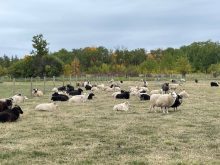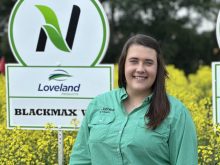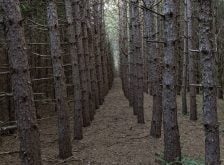Look before you leap! Check your seed before you plant.
Before getting into the topic of saving your own seed, whether it be cereals or legumes or any crop except for canola, I talked to several consultants and seed growers. Their answers were that few growers use all-new seed every year. These few exceptions actually use new seed annually. In the case of midge-tolerant wheat, though, it’s not advisable to use your own seed for more than one year past certified, due to loss of resistance.
Read Also

Claas brings 1000 Series SP forage harvesters to Canada
In mid-August, Claas unveiled its new line of Jaguar forage harvesters at an event in Visalia, California, deep in the heart of that state’s dairy region.
Many cereal growers — primarily of wheat, barley and oats — will buy some certified seed every year and multiply it up for their own requirements for the next couple of years. This is particularly true of new varieties which they want to try out, or because they need new clean certified seed due to contaminants in their own seed stocks.
Many farmers will send seed samples to one of the many Prairie or national seed testing laboratories to check up on their intended seed stocks. It’s good practice to know the germination of the seed lot, its vigour and the amount, if any, of destructive diseases such as fusarium head blight (FHB) in cereals or ascochyta on peas.
In their vigour and germination testing results, laboratories in Canada will of course list any destructive disease infestations, but they also may list fungal contaminants which are not disease-causing but merely seed contaminants. This listing of contaminants tends to confuse farmers and it should be the responsibility of the seed testing laboratory to point this out — that is, to distinguish between real disease-causing fungi and those that are simply seed contaminants.
If you did not forward your intended cereal or legume seed sample for germination testing to a recognized seed testing laboratory, you can very simply germ test your own seed.

A simple seed germination test
This simple seed test will at least tell you if your seed is viable — that is, still alive. You cannot assume that two- or three-year-old seed or even last year’s seed is viable. Wheat, barley, oats and pea seed, for example, like most other agricultural seed, except treated canola, can last for three to five years in the bin. If the seed is dry at 10 to 12 per cent seed moisture and it’s less than two years old, it’s likely good but the older the seed, the greater the loss of vigour and germination.
Take your seed sample after November (some seeds have a delayed germination) up to seeding time, April or later, and place on a folded wet paper towel on a nine-inch (23 cm) plate, preferably Styrofoam, and place 50 to 100 seeds spaced out on top of the wet towel. Place the plate inside a regular-size zip-locking plastic bag. Seal the plastic bag and place in a warm room, away from windows. If the room temperature is 20 C or higher, you will have your germination percentage in less than a week — or in a very warm room, at 25 C or higher, three days. Inspect the plates every day or so, and tilt to remove any standing water on the plate after day one. Do not open. After three to seven days depending on temperature you will have an answer. You can easily check the germination, whether it’s 24 per cent or 95 per cent or perhaps even zero.
READ MORE: Seed quality, seed supply and management tips for 2022
In my case, for example, I conduct a few bioassays annually, and I have often been surprised how quickly over four to five years most cereal grains, peas, beans and lentils can lose their viability. Put another way, you may think a bin of oats looks good but you were not sure when the seed was harvested a few years back. Cereals, beans, peas, lentils and other seed lots when dry at 10-12 per cent moisture can stand -40 C in the bin. They are preserved. What they cannot take, if expected to remain viable, is high summer temperature or high moisture. They can lose germination in as little as three to five years. If you really want to preserve a modest seed sample, it should be very dry, around that 10-12 per cent moisture, and kept in a freezer when it can remain viable for 20 years or more.

Factors that influence seed germination and vigour
- Did you have an early frost in August? Freezing at -2 C or less can either kill the seed, or reduce the food reserves in the seed and affect vigour.
- Could you have used a glyphosate spray before the crop was mature? I have seen many field crops, such as cereals and peas. produce seed that is severely compromised in germination and vigour. In one field of wheat back some years ago the glyphosate treatment resulted in only 10 per cent of the seedlings showing any vigour while the other 80 per cent germinated but then grew very slowly and poorly.
- Did the grain heat up in the bin? Heating causes the seed to use up lots of energy, usually with accompanying moisture. High heat can kill the seed or, at lower temperatures, compromise the seed viability.
- Was it a very dry season and your crop yield was less than 50 per cent of expected? This is especially true of cereals, where the actual grain kernels may have much less than 50 per cent of nutrient reserves. Such seed will be low to very low in vigour — that is, seedling establishment.
In the case of canola, most of the crop is grown from proprietary hybrid seed and is purchased annually. In the instance where the grower ends up with extra bags of canola seed, then there are several options. Either seed extra land, when possible; dispose of the seed by burying it; or place it at a disposal facility since it’s pesticide-treated seed that could be toxic to farm animals or wildlife. Alternatively, the bags could be kept for the next growing season, but the bags should be stored in a cool insulated building to reduce germination loss. Seed viability could be checked the following year. If the viability is low, you could make adjustments for the seed’s percentage of germination — or, if compatible, it could be blended with the current season’s new seed.
Seeding rates for your crop seed
Alberta Agriculture has a relatively recently revised six-page fact sheet, titled Using 1,000 Kernel Weight for Calculating Seeding Rates and Harvest Losses. This fact sheet shows you how the 1,000 kernel weight can vary not only from one crop to another but between varieties of the same crop and from year to year. It’s a little heavy on the reading but gives you an excellent insight into crop seeding rates and is certainly well worth the effort, economically speaking.
















